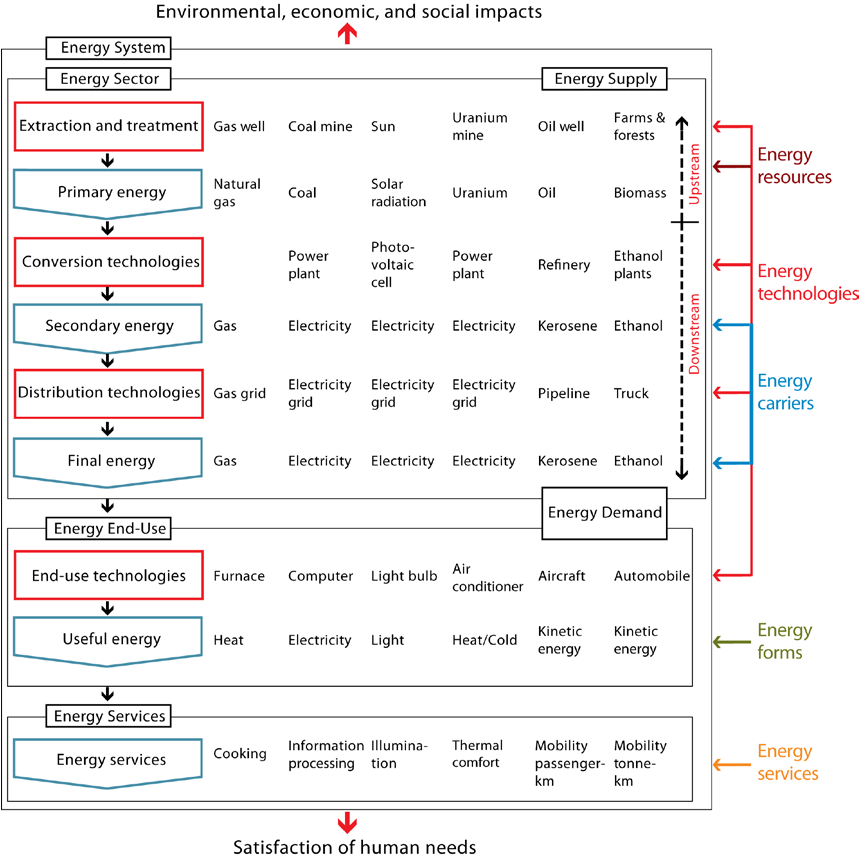Lecture 15 Review and Summary
Gang He
December 5, 2022
Start with two quotes
George Box:
All models are wrong, but some are useful.
Albert Einstein:
Everything should be made as simple as possible, but not simpler.
Energy systems

Source: IIASA, Energy Primier
What we have learned
- Energy systems
- Data
- Economics
- Technology
- Supply
- Demand
- Power
- Tools/skills
- Data analysis
- Economic analysis
- Life cycle analysis
- Energy-economy-environment (nexus)
How modelers think about an energy system
- System components, structure, and relations
- Networks (transmission, transport)
- Objectives and constraints (if do optimization)
- Validation and calibration
- Intepretation and communication
Data quality
- Availability
- Accessibility
- Credibility
Comparison, Validation, Verification
Project economics
- Project economics is useful for basic cost-benefit analysis
- Getting the price (discounting) right
- Understanding technology dynamics will help to model future projections
- Aware of the limitations
Energy sources and technologies
- Theory - learn and understand the physics of energy technologies:
- thermaldynamics (fossil)
- kinematics (wind)
- light and semiconductor (solar)
- gravity (hydro, tidal)
- atomic (nuclear)
- thermaldynamics (fossil)
- Practice - learn all kinds of corrections based on real-world situation
- The physics doesn’t change, corrections help us to do better job in simulation and projections
Energy demand
- Energy demand is shaped by dynamic factors: populations, GDP, technology, regulation, and human behavior
- Understanding those drivers will help us learn the magnitude and shape of our demand
- Load forecast integrates all insights to the show
Energy, environment, and human health
- Environmental and health impacts are the externalities of energy systems
- Energy-air-pollution-human health framework of analysis
- Energy-water-carbon nexus
- System impacts show the constraint in systems modeling
Energy and climate change
- IAM framework and models to analyze energy, emissions, and climate impacts
- Understanding the evolution of climate policy instruments
- Learn the applications and limitations of social cost of carbon
- Climate change affects energy supply and demand
Power sector analysis
- Power sector’s central role in decarbonization
- Capacity expansion model to analyze the optimized investment decisions
- Decisions in the real world is much more complicated
- Emerging trends in the power sector
Energy transition
- Diverse factors that drive energy transition
- Common and differentiated solutions to energy
- Leverage the advantages
- Addressing uncertainties: geopolitics, wars, pandemic, and more
Energy efficiency
- There are barriers for energy efficiency and inforamtion and standards can help address the energy efficiency gap
- Human behavior is complicated, and understanding it will help us to design policy
- Rebound is real but might be overplayed, rebound could be good if improve welfare
- Sustainable consumption and production within the limit
Energy poverty, access, and justice
- Electricity/energy access is fundamental to other modern services: education, health, and information
- Energy access also has gender equity, health cobenefits, and other implications
- Energy justice is important to achieve just transition
- An reflection on our approaches to energy justice
AI and big data for clean energy
- AI and big data has transformed how we live, and how can we save the planet
- AI does not automatic add new insights, but it provides powerful tools to analyze increasingly available big data
- Learning those new tools and skills becomes necessary to work in the field
- The potential of using AI/big data to analyze our understanding of energy supply/demand and human behavior is enomorous.
Limitations of models
- Know the limitations of models
- Use model appropriately
- Interpret/communicate the results effectively
- Modeling for social good
End with two quotes
Bill Hogan:
It is not the individual results of a model that are so important; it is the improved user appreciation of the policy problem that is the greatest contribution of modeling.
Huntington, Weyant, Sweeney “Modeling for insights, not numbers”:
The primary goal of policy modeling should be the insights quantitative models can provide, not the precise-looking projections –i.e. numbers – they can produce for any given scenario.
References
Hogan, William W. 2002. “Energy Modeling for Policy Studies.” Operations Research 50 (1): 89–95. https://doi.org/10.1287/opre.50.1.89.17803.
Huntington, Hillard G, John P Weyant, and James L Sweeney. 1982. “Modeling for Insights, Not Numbers: The Experiences of the Energy Modeling Forum.” Omega 10 (5): 449–62. https://doi.org/10.1016/0305-0483(82)90002-0.